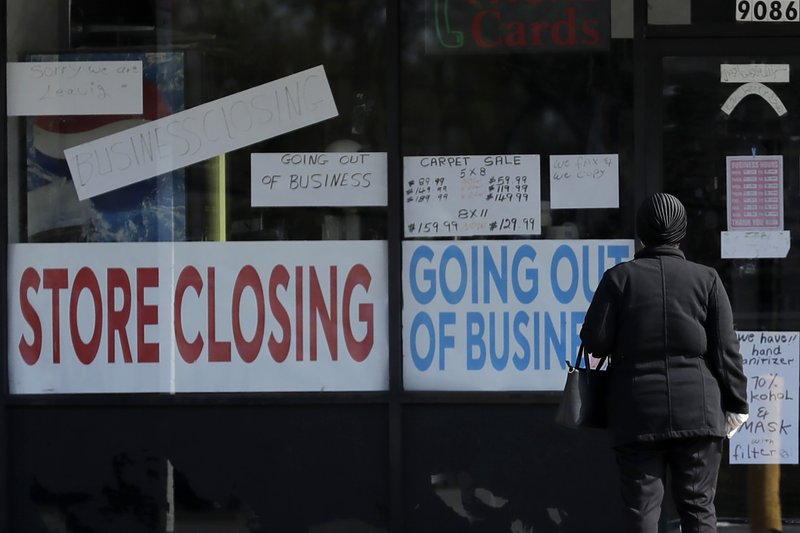WASHINGTON -- Nearly 3 million laid-off workers applied for U.S. unemployment benefits last week as the viral outbreak forced more companies to slash jobs even though most states have begun to let some businesses reopen.
Roughly 36 million people have now sought jobless aid in just the two months since the coronavirus first forced businesses to close down and shrink their workforces, the government said Thursday. An additional 842,000 people applied for aid last week through a separate program for self-employed and gig workers.
All told, the figures point to a job market gripped by its worst crisis in decades and an economy that is sinking into a deep downturn. The pace of new applications for aid has declined over the past several weeks but is still four times the record high that prevailed before the coronavirus struck hard in March.
One in five people who were working in February reported that they lost a job or were furloughed in March or the beginning of April, according to a new Federal Reserve survey released Thursday.
[CORONAVIRUS: Click here for our complete coverage » arkansasonline.com/coronavirus]
That pain was highly concentrated among low earners. Fully 39% of former workers living in a household earning $40,000 or less lost work, compared with 13% in those making more than $100,000, a Fed official said.
The waves of job cuts have heightened concerns that additional government aid, on top of the nearly $3 trillion already allocated, is necessary to sustain the economy. Without another aid package, many economists worry that thousands of small businesses will go bankrupt, leaving millions of the unemployed with no job to return to. And state and local governments, facing huge revenue shortfalls, could be forced to lay off millions more workers and cut services.
Fed Chairman Jerome Powell this week stressed his belief that Congress should consider providing additional rescue money to avoid prolonging an economic catastrophe.
Republicans in Congress are locked in a standoff with Democrats, who have proposed trillions more in aid. Republican leaders say they want to first see how the previous rescue packages affect the economy and have expressed skepticism about approving much more spending now. That sentiment has alarmed some economists.
[Video not showing up above? Click here to watch » https://www.youtube.com/watch?v=v9nwyJQn4Q0]
"There really isn't any sign that the labor market is bottoming out yet," said Daniel Zhao, senior economist at Glassdoor, the career website.
The Trump administration insists that as states reopen, more Americans will shop, dine out and resume other activities, thereby stimulating the economy. But early data suggests it is fear of contracting the virus, even more than shutdown orders, that may be impairing the economy. Without stronger public health measures, such as widespread testing or a vaccine, economists say such fear will depress growth even as more states reopen their economies.
Even though Georgia reopened its restaurants for sit-down dining late last month, Adam Ozimek, chief economist at Upwork, said data from the reservation site OpenTable shows that reservations are still 91% below their pre-virus level.
"Simply ending lockdowns is not going to be a panacea for these companies," Ozimek said. "People aren't going out because they don't feel safe yet."
State and local governments, which cut nearly 1 million jobs in April, are running out of money and collectively posing a threat to the national economy. The recession will likely produce the sharpest plunge in state tax revenue since the center began tracking such data in the early 1970s, said Lucy Dadayan, senior research associate at the Urban-Brookings Tax Policy Center.
In the meantime, jobless workers in some states are still reporting difficulty applying for or receiving benefits.
The latest jobless claims follow a devastating jobs report last week. The unemployment rate soared to 14.7% in April, the highest rate since the Great Depression, and employers shed 20.5 million jobs. A decade's worth of job growth was wiped out in a single month.
Even those figures failed to capture the full scale of the damage. Many workers in April were counted as employed but absent from work but should have been counted as temporarily unemployed.
Millions of other laid-off workers didn't look for a new job in April, likely discouraged by their prospects in a mostly shuttered economy, and weren't included, either.
Most economists have forecast that the official unemployment rate could hit 18% or higher in May before potentially declining by summer.
Many Americans came into the ongoing nationwide lockdown with limited savings, despite gains made over the course of a record-long economic expansion. At the end of 2019, 3 in 10 adults said they could not cover three months' worth of expenses with savings or borrowing in the case of a job loss, "indicating that they were not prepared for the current financial challenges," the Fed report said.
"It's like we have the same storm, but we have very different shelters," said Mary Daly, president of the Federal Reserve Bank of San Francisco. "Some of us are well-sheltered. We can tele-work.We [have] college degrees. The work we do is more resilient to the shelter-in-place and the coronavirus."
Others are "almost completely unsheltered," she said in an interview. "When we shut down the economy, they have to go home. ... And they're in industries that may be the slowest to recover."
"It's hard to imagine that the economy can flourish with half the population struggling just to make financial ends meet," said Mark Zandi, chief economist at Moody's Analytics.
Information for this article was contributed by Christopher Rugaber, Martin Crutsinger and Travis Loller of The Associated Press; by Jeanna Smialek of The New York Times; and by Don Lee of the Los Angeles Times.
Business on 05/15/2020
